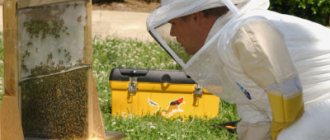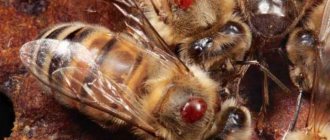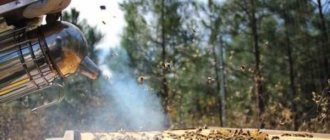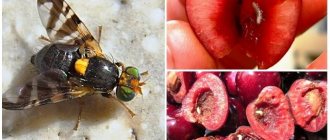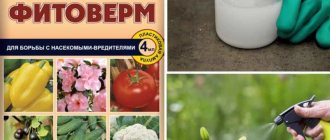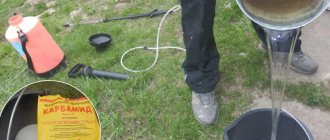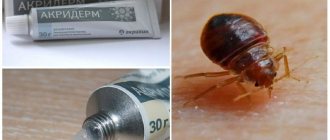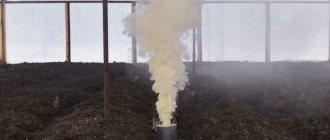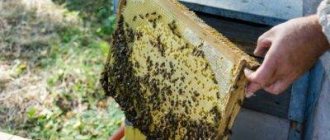Pharmacological properties: The active ingredient of the drug (amitraz) is a systemic acaricide, effective against Varroa jacobsoni mites. The drug does not have a negative effect on the life of bee colonies. The LD50 of the drug for bees is 10.0 mcg/bee.
Indications: Varroatosis (varroosis) of bees.
You can buy Bipin from us by calling:
ACTIVE SUBSTANCE IN BIPINA: amitraz.
Doses and method of administration: Used in the form of an aqueous emulsion. A working emulsion is prepared by thoroughly mixing 1 ml of bipin and 2 liters of clean water. The drug solution prepared in this way is used during the working day. Bee colonies are treated in the fall during the formation of the club and in the absence of brood, at an outside temperature of at least 0 ° C. Treatment of bee colonies is carried out by finely pouring a prepared working solution of bipin from a syringe into the interframe space twice with an interval of 7 days. Dose - 10 ml per street. A 2-fold application is recommended: 1 treatment immediately after the end of honey collection and pumping out of honey, 2 treatment before placing the colonies for the winter (if there are varroa mites on the bees).
Side effects: Not observed.
Contraindications: Do not treat families with a force of less than 4 - 5 streets.
Special instructions: Honey from bee colonies treated with bipin can be used for food without restrictions.
Storage conditions: List B. In a dry, cool, dark place at a temperature not lower than 0 °C.
Shelf life: 3 years.
Manufacturer: Api-San LLC, Russia
Reviews about the drug Bipin
I would like to share my experience in treating bees for mites. I've been keeping bees for over 10 years. When I acquired them there were 1-2 mites on each bee, not counting lice. I used bipin. I used half the recommended dose. The result was very good. The loss of bees is not large. About two years later I decided to try to catch a swarm in the forest. I caught it and brought it. A month later there is a huge number of mites throughout the apiary.
You can order Bipin in Ukraine by phone:
There are already 3-4 drones on the brood. I decided to try the “tested remedy-Bipin” again in the fall. Same dosage. After the first treatment, in strong colonies the loss of bees was 50% or more. True, the tick also died. But at what cost! I didn’t use bipin for two years and forgot about the insidious “medicine”. The next time I used it, the result was the same, a large loss of bees. I haven’t used Bipin for about five years. I don’t catch alien swarms. I use drugs to treat bees from trusted suppliers. There are very few ticks in the apiary. And I advise poor neighbors whose bees are dying “for some unknown reason” not to be greedy and to buy good medications. After all, everything you invest in bees pays off if you act wisely.
Ambient temperature when using Bipin T
Let us warn you about the obvious question: when are bees treated with Bipin?
In autumn, spring and summer. If necessary, it is carried out when required, but there are recommendations. In order for the drug to have
the maximum effect , it is necessary to carry out treatment on time, when the number of brood in the families is minimal.
The drug does not kill mites in sealed brood, and they remain alive. The air temperature for processing families, recommended by the manufacturer, is +5 C º. Early spring and late autumn are the times when there is a minimum of brood in the hives. Treatment cannot be carried out at sub-zero temperatures or in extreme heat.
Practice shows that for the normal functioning of a bee colony, it is enough to treat the apiary with Bipin T once a year in the fall. Autumn treatment allows you to destroy the parasite by 98%, localize the outbreaks and prepare the colonies for the winter.
What is a smoke cannon?
Amitraz, the active substance of Bipin, and the pyrethroid fluvalinate, the active substance of aquaflo, are moderately hazardous to humans (hazard class 3).
Their residual quantities are unacceptable in honey according to European standards. A smoke cannon is a unit that is used to fumigate bees with varroatosis. The principle of operation of a smoke gun is based on the evaporation of various substances at high temperatures. The combination of evaporation of the substance and the irritating effect, due to which parasites fall off from honey-bearing insects during their intense movements, highly effective procedure is achieved.
The smoke cannon consists of:
- gas burner;
- gas cartridge;
- gas supply valve;
- pump for supplying the liquid component;
- tank;
- fryer;
- nozzles;
- bolt for adjusting the amount of working fluid.
The average weight of a smoke cannon is 1.5–2 kg, its cost varies between 3,700–4,500 rubles.
Rules for preparing the solution
How to properly prepare medicine and use it with bees? The ampoules contain a concentrate; it cannot be used in the form in which it is produced. In order for the drug to be used for spraying an apiary, a solution must be prepared from it, taking precautions when working with a toxic substance.
1 ml of Bipin is diluted in 2 liters of warm water, the temperature of which does not exceed 40°C. The result is a milky white liquid. Exceeding this dosage leads to the death of the entire bee family, and if the product is diluted in more water, it will not give the desired effect.
The solution has a shelf life of 24 hours. Unused fluid should be discarded. The solution is kept in closed containers; combined with its high volatility, this toxic substance can cause serious harm to humans.
basic information
Treatment of insects against varroa is an important process in modern beekeeping. The life of bee colonies in winter and their development throughout the season depend on this.
The Varroa mite not only causes great harm to insects, but is also a carrier of viruses and diseases, for example, acute or viral paralysis.
Tomato variety “Crimson Giant”: description, characteristics, sowing seedlings, fertilizing, yield, photos, videos and the most common tomato diseases
This pest appeared in the USSR about 50 years ago. It began to develop rapidly, causing a lot of harm to beekeeping. But after some time, a way was found to cope with this scourge. But since beekeepers were unable to completely get rid of the mite, they constantly prevented the spread of the disease.
Indications and contraindications
The product “Bipin” is necessary for bees to protect against Varroa mites. Before the invention of special means, billions of bees around the world were destroyed by this terrible insect. Millimeter ticks wait for prey on flowers. The pest deftly jumps onto the bee, attaches itself to it and enters the hive. Varroa, by penetrating the hemolymph and replacing the circulatory system, transmits the dangerous “deformed wing” virus to the striped workers (and subsequently to the brood). As a result of infection, new bees are born with large defects - without wings or without legs, for example.
In one summer, the female parasite is capable of laying eggs more than 3 times. Mites can live with bees in the hive for about six months, including the winter period. It is not difficult to imagine the scale of destruction of bee colonies. In 30 days, the tick moves a distance of 11 km. and infects all nearby apiaries along the way.
The bottom line is that the beekeeper will not immediately notice harmful phenomena in his farm. Obvious symptoms of infection from ticks appear only a year after infection. Without early action, bees die. They cannot fly, which means they cannot eat. As a result of the actions of Varroa mites, bee larvae become unviable and rot.
In such a situation, preventive measures are a panacea for a tick-borne epidemic. These mites appeared in our country half a century ago. Soon, Soviet scientists invented an effective chemical for beekeeping called “Bipin”. Since then, Russian beekeepers have been successfully using it.
Advantages of the medicine:
- Performance. “Bipin” works immediately. After half an hour the ticks begin to die.
- Efficiency. Primary treatment allows you to destroy up to 99% of pests in 12 hours. The procedure can be carried out at temperatures from +5 to -5 degrees.
- Safety. Despite the fact that the product is moderately toxic, it affects the condition of bee colonies. Moreover, bee honey can be consumed after Bipin.
The medicine is contraindicated in weak bee colonies (less than 5 hives). Also, don't overdo it. Overdose is harmful. Cannot be used in its pure form.
Before the procedure, experienced beekeepers advise testing “Bipin” on 2-3 families to make sure whether it is possible to treat bees against mites during this period.
Treatment of varroatosis
There are a wide variety of therapy methods: zootechnical, chemical, physical, and folk. However, regardless of its effectiveness, no treatment measure can completely destroy parasites.
Physical methods
Such methods involve thermal treatment of cells using a pressure chamber. The effect of this therapy is that the bees are more resilient and are able to withstand high temperatures at which varroa mites die. This method is usually used in the fall (in the evening or morning).
Chemicals
There are drugs available on the market in different forms. However, before using this or that product, you must carefully study the instructions, and, in the future, strictly adhere to them. Otherwise, increasing the dosage may lead to the death of bees. And, on the contrary, when it decreases, mites cease to be sensitive to the drug.
It is also worth paying attention to the drugs Tactic and Bipin, as they are not addictive. (They are recommended for use in late autumn treatments)
Traditional methods
The safest are traditional methods, since side effects from the use of these remedies are minimized. Therefore, many beekeepers prefer them.
The most common remedy is herbal fumigation. To do this, the smoker needs to be filled with rotten mushrooms, propolis peelings, chaga particles, tansy, wild rosemary, burdock and horseradish roots, and tobacco. This mixture is set on fire and smoke is pumped into the hive (up to 15 cubic meters). In this case, the tapholes must be closed for 5 hours. This procedure should be repeated every 5 days, preferably several times.
In addition, it is recommended to use pine infusion - it will not only have a therapeutic effect, but also serve as a vitamin supplement. The method of preparing it is very simple: you need to pour boiling water over pine or spruce needles and then let the resulting product brew. You can also add garlic. The mixture is combined with syrup in a ratio of 1:5 and given to the bees.
Pharmacological action and composition
Bipin is a contact drug that contains amitraz, an ingredient with toxic properties. It paralyzes the limbs of ticks, making them incapable of sucking. Within 3 hours after treatment, ticks leave their hosts. After another 3 hours they die. In case of overdose, the drug can lead to death. Therefore, before use you need to study the instructions.
It should be noted that bipin was developed by employees of a scientific institute of the Soviet Union. Its toxicity was calculated both with and without insect infection. About 50 bee colonies were used for testing. Therefore, there is no need to doubt the high quality and reliability of the drug. After the first treatment, 95-97% of parasites die.
But you should not hope for a complete victory over ticks, as they have increased vitality. Even after several very harsh disinfections, some parasites survive and continue to reproduce.
Processing nuances
It is quite difficult to treat varroatosis; it is best to pay special attention to prevention in order to prevent infection by mites. If parasites appear, then it is necessary to carry out treatment, taking into account some nuances:
- after opening the ampoule, the medicine quickly (within 24 hours) loses its properties;
- An undiluted solution cannot be used for processing;
- The drug should be dissolved in warm (30-40°C), but not hot, water;
- the product does not destroy parasites located in cells with brood;
- it is not necessary to disinfect hives during the period when the younger generation is growing up;
- It is not recommended to treat bee colonies weakened by disease or for other reasons that have not gained even 5 streets, which can provoke their death;
- in no case should you increase the dosage, which can lead to poisoning and death of the bees;
- It is recommended to treat bees against mites twice in the fall with bipin at weekly intervals.
Beginners are advised to first test the effect of the drug on several hives. To test its effectiveness, you can place a white paper sheet on the bottom of the hive. After 3 hours, dead ticks should appear on it.
It is necessary to check the expiration date of the drug. Its effectiveness lasts for three years. Expired medication will not only not provide the desired result, but can also cause the death of insects.
Release form
Sold in glass ampoules as an emulsion for dilution with water. The drug is available in different volumes (0.5 ml, 1 ml, 2 ml, 5 ml, 10 ml). The smallest jar is designed for 10 doses.
The color of the emulsion ranges from transparent to yellow. The smell is stinky, pungent. Produced in Russia by the Agrobioprom company in 2 types, the characteristic features of which are presented in the table.
| Name | Suitability | Color | Season of use | Peculiarities |
| “Beepin” | 3 years | Transparent | Autumn | – |
| Bipin-T | 2 years | Yellow | Autumn and spring | Contains the substance Thymol (improves the condition of bees after infection). |
Treatment with Bipin is easy
According to the instructions for use of the drug, Bipin destroys up to 99% of the entire tick mass! Is it possible to treat bees with the drug so that every bee is covered with it? How to make sure that the medicine gets to every corner of the bee house? Such questions torment “young” beekeepers very often.
You can treat the apiary using different methods
If you have a smoke cannon on your farm, this is the first option.
Smoke cannon treatment is the easiest and fastest way to treat bees. Bipin is dissolved for the gun in the proportion: 1 ml per 40 ml of water. The calculation of the number of hives is simple - 1 “puff” or one smoke cloud, at a time for 1 hive. It is necessary to launch the cloud into the hive 2 times, with a short break between smokes. One smoke cloud is approximately 2 ml.
You need a simple medical syringe - the second option.
Bipin is diluted according to the instructions. It is better to buy a 10 ml syringe, this is exactly the required volume of diluted solution for one frame street, according to the instructions. It turns out that if you take 1 ampoule and dilute it in two liters of water, then this volume (2,000/10=200) will be enough for 200 streets. You'll have to count the streets.
Squeeze the medicine out of the syringe evenly between the frames. We collect it again and squeeze it into a new street. Not a very labor-intensive process. Any amateur can repeat it, even without experience.
A plastic bottle with a hole in the cap is the third option.
Bipin is diluted according to the instructions. A small hole is made in the cap of a plastic bottle. It is screwed onto the bottle in which the drug was mixed, instead of the previously installed cap. Squeezing the bottle with your fingers, create a stream of liquid and direct it between the frames.
By eye, looking at the number of bees in the street, we spray the medicine. Full street: spray from the beginning to the end of the street. If there are few bees: pour only on the existing bees, simple and effective.
The plastic sprayer “Rosinka” is the fourth option.
A good option, but suitable only for small apiaries. You need to take out each frame and spray it. Reliable method, but time consuming.
Treatment of bees with Bipin in the fall must be carried out 2 times
First time: after pumping out honey in August. They destroy the mite that is on the worker bee. After this treatment, it is easier for the bees to make the last preparations for the winter.
Second time: after the release of the last brood. Parasites can no longer hide in brood cells and are all found on the bees. Thanks to this situation, the effectiveness of Bipin treatment is 99% in destroying the pest.
Instructions
So, you are a beekeeper who cares about the productivity of your apiary and the health of your bees. You know about the harmfulness of varroatosis, so you decided to take preventive measures with the help of “Bipin”. Below are detailed instructions for treating bees with the drug.
Application period
“Bipina” poison is used in the off-season, during the absence of brood. This is autumn (early September, before hibernation) and after the final honey harvest. With Bipin-T it is allowed to carry out spring treatment. During a particularly hot summer, when a tick attack is inevitable, it is permissible to spray the product without waiting for autumn.
Description of cabbage weed (mole cricket) and how to fight it
Regardless of the season and type of poison, the procedure is carried out twice with an interval of a week.
Dosage
For 10 ml “Bipina” – 20 l. water. Accordingly, for 5 ml. products – 10 l. water, 2 ml. – 4 l., 1 ml. -2 l. and so on. 1 ml. – this is 20 doses. The calculation is as follows: 150 ml. – for a strong hive (10 ml per cell). After dilution, the medicine acquires a milky color.
Tools
Water – clean, potable, warm or at room temperature. Sprayers:
- automatic syringes;
- bottles with dispenser attachments;
- spray;
- syringe;
- homemade sprayers.
As a means of destruction, some beekeepers use a special smoke cannon (sold in beekeeping stores). That is, treatment with medicine occurs not by spraying, but by fumigation (1 ml of “Bipin” per 40 ml of water). You can treat with smoke at a time (2-3 circles), without a 7-day interval.
According to reviews, ticks die in the first 15 minutes. To see the results, white paper is laid on the floor of the hive, which, after fumigation, is completely covered with mites. The bees, twitching from the smoke, throw off the pests.
This device runs on kerosene. It is important to wear a mask on your face during treatment. Inhaling medicinal vapors is dangerous for humans. At a minimum, allergies or skin irritation may develop.
Procedure
Freshly prepared emulsion is stored for only a day. Therefore, it is advised to dilute the poison directly in the apiary:
- Open the hives;
- Remove the pillows;
- Without removing the frame, you spray the poison.
Try to distribute the liquid evenly so that each bee gets at least one drop.
Analogs
Among the treatments for variotosis, the following types of drugs can be distinguished:
- Chemical emulsions – “Amitrazine”, “Apitak” (analogues of “Bipin”), “Bisanar” (thymol + oils), “Aqua-flo” (fluvalinate);
- Natural remedies – fir essential oil (wet the tompons and place them in frames), pine flour (sprinkle on insects), acids – oxalic, formic acid (“Ant”, “VarroNet”);
- Cardboard strips with acaricidal impregnation - “Akarasan”, “Amipol-T”, “Apides”, “Varrosan”, etc. (they burn and treat the hives with smoke);
- Gel (put a bag of medicine at the bottom of the hive) - “Apigel”.
All these medications are aimed at removing ticks. Natural remedies work effectively, but not immediately.
Chemicals destroy quickly and cleanly. In addition, each beekeeper chooses a convenient method of application.
Stripes
Strips impregnated with substances that kill ticks are intended for long-term use. They can be used throughout the spring and summer to prevent bee infection. At this time, insects are active and move throughout the hive, so they spread the insecticide throughout the entire internal space.
When the temperature drops below +10°C, swarming begins and bees gather in a limited area. Thus, in the autumn period, funds in this form are ineffective.
Amitraz
This drug belongs to the group of acaricides and is used to combat parasites in the fall. The product is toxic, so it should be used after the last honey collection. When processing, you must follow the instructions.
Oxalic acid
To rid the hive of parasites, you need to dilute 2 g of acid with 40 ml of water. The container with the drug is suspended in the corner above the nest for 3-5 days. The acid evaporates, which leads to the death of the mites. It is better to use this product at a temperature of +15°C...+25°C.
Amipol T
This drug is intended for the treatment of honey insects by contact method. It is produced in the form of plates (wood or cardboard), the thickness of which is 1 cm. Each strip is impregnated with fluvalinate, which kills ticks that come into contact with it.
Thymol
Thymol is an effective means of combating not only varroatosis, but also tracheal mites and foulbrood. But with all this, thymol does not harm the honey workers themselves and their products. But you must stop using the drug 7 days before pumping out honey or collecting other bee products.
If we talk about the complex effects of thymol, it provides the following effect:
- Bactericidal.
- Fungicidal.
- Acaricidal.
- Nosemacidal.
It is most effective to use in the spring, when the flight ends. But in the fall, before they go to winter, in order to increase the strength of the family, Timol should also be used.
Treat with the drug 2 times with an interval of 7 days when painting according to the outer frames.
When exposed to each frame, completely planted with individuals, it is necessary to act 3 to 4 times with an interval of 3-4 days.
Vetfor
Vetfor is also a record. The only active ingredient here is amitraz. The composition also includes fir oil and dimethyl sulfoxide.
Formic acid
To treat bees, a composition with an 85% concentration is used. 40 ml of the product is poured into a separate container and placed in a corner of the hive for 3-5 days. The acid fumes will kill the ticks.
Acaricide
This drug is available in the form of a solution and plates. It is enough to treat the hive once to reduce the number of parasites.
Biological drugs
The following are used against mites in bees:
- Formic acid. This substance is diluted at a concentration of 85-87% before processing. 40 ml of the drug is poured into a special container intended for acid and suspended in one corner above the socket. The acid evaporates within 3-5 days. This treatment should be carried out at an air temperature of +15-25 degrees;
- Oxalic acid. For high-quality treatment of the hive, only 2 g of the substance is required, which makes this product more profitable in terms of financial costs. Oxalic acid is placed in the hive slightly heated. Otherwise, the application method is similar to the previous method.
Symptoms of the disease
Signs of varroa depend on the number of parasites. The higher the level of infestation, the more pronounced the symptoms of the disease, which include:
- young animals that have just hatched from eggs have smaller body sizes. His life expectancy and resistance to other diseases will also be low. Insects may have visible defects in the form of defects in the wings, legs and other organs. Infected individuals do not take part in the labor activity of the bee family, moving aimlessly around the hive, at the bottom of which there are also diseased larvae and drones. If you look closely, ticks can be detected visually;
- In case of massive varroa infection, in the last stages of the disease, a huge number of insects and pupae die, which healthy bees throw out of the hive. The emerging brood has a variegated color, and the larvae in the cells become yellow and covered with mold. In the summer, incapacitated individuals hatch from the infected larvae and are immediately expelled from the home;
- Infection with the Varroa Jacobsoni mite causes anxiety and irritation in bees. If healthy bees in the fall are in a hurry to create a club in order to take the warmest place in the hive, then sick individuals are in no hurry to do this, thereby enduring the winter poorly. As a result of this, they begin to excessively devour the prepared food, which often ends in the death of the insects. By spring, the infected family, at best, is greatly weakened, and at worst, completely dies.
How to spot ticks
The appearance of mites is indicated by uncharacteristic behavior (restlessness and aggressiveness) and weakness of insects, defects in the offspring, a decrease in the life expectancy of bees, a decrease in the volume of honey collection, and an increase in the amount of waste.
Brown spots similar to millet grains may appear on the body of insects. When mites multiply excessively, they completely paralyze the performance and vital processes of bees. If you do not get rid of parasites, then in a year they can turn a thriving apiary into a collection of barely moving bees, unable to even feed their offspring.
Safety measures during work
Bipin is used to remove varroa mites, which parasitize bees, and is a substance with a moderate degree of toxicity.
Treatment of bees is achieved with a certain dosage in a sprayed state using a smoke gun. Bipin is a toxic and flammable solution, so you must follow safety precautions when carrying out the procedure:
- be sure to wear gloves to avoid splashes of the product on bare skin;
- use RPG respirators with chemical protection cartridge “B” to prevent smoke from entering the respiratory tract;
- put on a robe;
- use glasses.
You should not smoke or eat food with water during the procedure. When processing, you need to move only in the wind to prevent vapors from entering the respiratory tract.
It is imperative to observe the proportions of the concentration of Bipin - in case of an overdose of the drug, the death of the offspring of bees may occur. You should also collect the honey first so that the product does not get on it.
It is necessary to carefully monitor the integrity of the unit, since its mechanical damage can lead to solution leakage.
After handling, you should wash your hands thoroughly.
Does the product affect the quality of honey?
Novice beekeepers doubt whether it is worth using such strong chemicals to treat bees, because they can affect the quality of the product. Will honey obtained from bees treated with Bipin be toxic to humans?
Czech scientists conducted a long-term study - they studied beekeeping products in an apiary processed by Bipin for 20 years. Researchers were unable to detect traces of the drug in honey. The drug does not affect the quality of honey and does not accumulate in it. It is absolutely safe for humans.
Recommendations
Before use, pay attention to the expiration date (maximum shelf life is about 5 years from the time of spilling). If the expiration date has expired, the ampoules must be disposed of immediately, because they are considered useless. The medicine should be stored at a temperature of 15-18°C.
It is prohibited to store an open ampoule. It is recommended to open it 1-2 hours before starting to prepare the solution. The longer the ampoule is left open, the faster the medicinal substance begins to deteriorate and may become ineffective.
It is recommended to treat the evidence 10-15 days after the insects brood. During the first treatment, more than 90% of insects are destroyed. After 2-3 weeks, you need to treat the apiary again for complete destruction.
